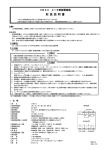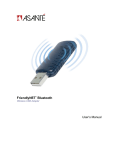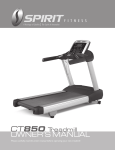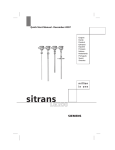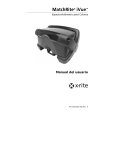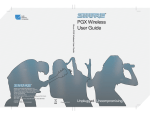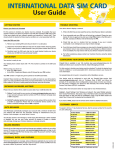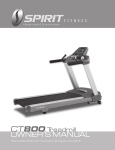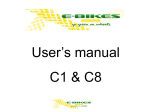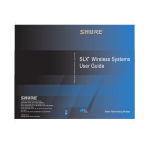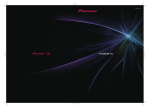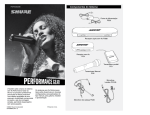Download LG_200E - User Manual Online
Transcript
For LiteGait I-200 Models WARNING * Maximum patient weight: LGI-200 200 lbs. * Use only under the direct supervision of a health care professional or caregiver * Brakes should remain locked except when moving over ground * Operate only on a smooth, level floor Dear LiteGait User, CONGRATULATIONS on your recent purchase of LiteGait, the most innovative gait and balance therapy training system available today. As you know, LiteGait can be used with a wide variety of patient impairment levels and conditions. If you have questions about the possible uses of LiteGait with particular patients, or are in need of some ideas for ways to use LiteGait more effectively, please do not hesitate to contact us for information relating to your individual situation. Our website also offers valuable information. Like all quality therapy equipment, LiteGait requires regular inspections. Enclosed is a check list for your convenience. Please complete the check list every 6 months to ensure the efficient, safe, and effective operation of the LiteGait unit. If you should find a problem with a LiteGait part, please contact the Technical Support Department immediately. Here are some phone numbers which will be of help to you: TECHNICAL SUPPORT: SALES & CUSTOMER SERVICE: E-Mail: Website: Sincerely, Customer Service Department Mobility Research 480-829-1727 800-332-9255 [email protected] www.LiteGait.com TABLE OF CONTENTS ABOUT YOUR UNIT. . . . . . . . . . . . . . . . . . 5 ASSEMBLY DIAGRAM . . . . . . . . . . . . . . . . 8 UNIT ASSEMBLY. . . . . . . . . . . . . . . . . . . . 9 USING LITEGAIT . . . . . . . . . . . . . . . . . . . 12 OPTIONAL BiSym SCALE . . . . . . . . . . . 14 HARNESS APPLICATION TIPS . . . . . . . 17 UNIT CARE. . . . . . . . . . . . . . . . . . . . . . . . 26 PARTS LIST . . . . . . . . . . . . . . . . . . . . . . . 27 MAINTENANCE CHECK LIST . . . . . . . . 31 TROUBLE SHOOTING . . . . . . . . . . . . . . . 33 RESOURCE DIRECTORY . . . . . . . . . . . . .35 WARRANTY . . . . . . . . . . . . . . . . . . . . . . . 36 ABOUT YOUR UNIT LiteGait is comprised of several parts. We separate them into 6 subgroups or subassemblies for classification according to function. The groups are 1) Yoke, 2) Harness with straps and groin pieces, 3) Base, 4) Post, 5) Power System, and 6) Handlebars. In addition to these components your unit may come with optional equipment. The following descriptions provide you with an overview of the sub1. Yoke: The yoke is a bent Yshaped piece that has four female buckles at the ends. It is attached at the top of the actuator with a flat plate secured by four bolts. 2. Harness, Straps and Groin Pieces: The harness is an adjustable wrap with three buckles in the center front and six adjustment straps— three on each side. There are four metal connectors at the top of the harness that connect into the black female buckles of the overhead straps. Each unit is equipped with a set of four 44” long adjustable straps with male connectors at the top and padded female buckles at the opposite end. Overhead straps connect to the yoke buckles to support the individual. Harness and Groin Pieces At the bottom of the harness there are four female Fastex buckles that connect the groin pieces. The well padded groin piece has four male Fastex buckles that connect to the buckles at the bottom of the harness. The stitches on the groin piece denote the top (body side) of the piece. 5 3. Base: The base consists of two horizontal bars connected by two U-shaped tubes. The base has an open end where an assistive device might be placed and a closed end where the actuator and power system is stored. The base rides on four wheels known as casters. Two casters on the left are locking casters and the two on the right side are directional locking casters. The locking casters will brake the system. Directional casters when locked will maintain straight rolling. 4. Post: The center post transfers the supported weight from the yoke to the base. Adjustable posts are equipped with a mechanism known as the actuator. The actuator consists of concentric expanding or retracting square towers that house the DC motors, gearing and drive screw mechanism to provide lift. The actuator also provides the structure to which the adjustable handrails are attached. The actuator pictured here is has connectors at the top and bottom, which is unique for the actuator. The cord will always connect to the base connection. 5. Power System: The power system consists of a battery, charger, hand switch, cords, cover plates, control box, and optional wall units. Battery The battery is a rechargeable lead acid battery with a fuse for protection. The battery is shipped fully charged and should be stored charged when not in use. The control box houses the electronics and connects battery, hand switch, and cord to the actuator. When the battery charge begins to drop off the control box will make and audible beep as a warning to recharge the battery. CB7 Current Limit Box The picture illustrates the control box and current limit box removed from the base. The actuator cord connected to bottom of the actuator The charger is connected to a standard 110-volt 15amp wall outlet. The other end connects into the control box to charge the battery. 6. Handlebars: The handlebars are attached to the post or actuator. The handlebars are padded with a material to ensure comfortable and confident grip to steady the patient’s gait. The height is easily adjusted with knobs for positioning the handlebar at comfortable level for the patient. Care must be taken to avoid over-tightening handlebar knobs to avoid stripping the bolts. Adjustable handlebars have pins to change the length to suit the patient as well. 110 V Charger ASSEMBLY DIAGRAM Yoke Buckle Assemblies Actuator Handlebar Assembly Battery Compartment Hand Switch Maxilock Casters Base Frame Directional Casters 8 UNIT ASSEMBLY Tools Required: x x x x Adjustable wrench or ½” and 9/16” wrenches ¼” Allen wrench Utility knife or scissors Flathead screwdriver LiteGait I Assembly Instructions: TWO PEOPLE ARE REQUIRED FOR SAFE ASSEMBLY Read below & follow pictures on the following pages: 1. Inspect shipment and note any visual damage to box and/or crate 2. Remove screw located at the bottom of crate 3. Lift off exterior box in order to expose equipment 4. Loosen handle bar knobs and raise handle bars 5. Remove cardboard box, (CAUTION: DO NOT USE UTILITY KNIFE TO OPEN BOX) 6. Inspect contents of card board box for damage 7. Carefully cut all black plastic straps. 8. Free and remove base with two people. 9. Set base over pallet as pictured with actuator next to base. 10. Cut packaging from base. 11. Locate and remove hand switch from inside base, set aside next to control box. 12. Remove covers for battery compartment and control box cover; set aside. 13. Locate 4 black steel bolts and Allen wrench in small box. 14. If black bolts are in base, remove with Allen wrench provided. 15. Locate bolts holding actuator to pallet. Undo bolts with ½ inch socket or wrench, loosen actuator from pallet with one person holding the actuator steady while loose. 16. Lower handlebar base on actuator and tighten knobs before lifting. 17. Ensure base is ready for positioning actuator. 18. Two people lift actuator from pallet to base. 19. Orient the actuator on the base (the yoke arms and handlebars point in the same direction as the base legs). Line up the holes for bolts to be inserted. 20. Insert bolts, hand tighten bolts (ensure one person holds actuator steady until secure). 21. The 5/16 inch Allen wrench may be used to tighten bolts (careful not to over tighten). 22. Line up actuator connector, and insert actuator connector. 23. Twist/release the red button; check 4-bar battery indicator on control box. 24. Verify connection and operation by moving actuator up/down by pressing the arrows on the hand switch. 25. If hand switch fails to operate the actuator, check connections to control box. 26. Carefully remove all shrink-wrap from the unit. 27. Verify performance of each locking and directional caster. 28. Feel free to call 1-480-489-1727 Extension 7104 for Mobility Research Support during this assembly. 9 Uncrating and Assembly Instruction for LG I –200 1. Inspect box for damage 2. Undo base boards screws 3. Remove box and set aside Expose & examine content 4. Loosen knobs 5. Remove box Open box (CAUTION: DO NOT USE UTILITY KNIFE) 6. Inventory box content 7. Cut straps Cut straps 8. Free and remove base 9. Set base over pallet 10. Cut packaging from 11. Locate; remove hand switch Move hand switch to side 12. Remove covers; set aside 10 13. Ready base for actuator 15. Remove bolts; ½” wrench 16. Lower Handlebar base; secure 18. 2 people raise actuator 19. Set actuator on base Line up holes; insert bolts 20. Hand tighten 21. ½”wrench; don’t over tighten 22. Line up actuator con- Insert actuator connector 23. Release Red EMO button 4 battery indicator bars 24. Test raise actuator up/down Unwrap casters 26. Remove shrink wrap; Do Not use knife! Scissors if necessary, avoid cutting socks 27. Directional-Lock caster 11 Locking caster Pull up to unlock casters USING LITEGAIT Casters LiteGait is equipped with four casters. There are two standard casters and two directional lock casters. Each leg has one type of caster. Directional lock casters have a black brake lever. Standard casters have a silver brake lever. How to lock the caster brakes Depress the caster brake on all four casters. The caster brakes should be locked whenever the LiteGait is not being moved over the ground. CAUTION: While locking the casters prevents rolling of the unit, it does not prevent the unit from sliding on a sloped, slippery floor. The unit should only be used on a flat floor and away from stairs and ramps. NEVER leave a patient unattended in the unit. Directional Lock Casters Directional lock casters facilitate rolling the device back and forth over a treadmill. The directional lock casters will have a black brake. 1. Position LiteGait near the treadmill (or where you wish the patient to begin walking). 2. Roll LiteGait towards the front of the treadmill, until the casters line up parallel to the treadmill (or parallel to the path the patient will follow—a hallway for example). 3. Depress the directional locks. This will prevent the caster from pivoting. 4. LiteGait can now be easily rolled back and forth over the treadmill or on a straight path in the therapy room or hallway. 5. For over treadmill, all four caster brakes need to be pressed. 12 NOTE: When walking patients over ground, first establish the direction of movement, then lock the directional castors to ensure the best performance. To move in the opposite direction, release the caster brakes and re-establish the direction of movement. That is, allow the casters to follow the movement rather than lead it. How to adjust the height of the yoke The LiteGait powered yoke is raised and lowered by a hand held switch with up Ï and down Ð arrows. Raising the yoke: Verify that LiteGait has clearance above the yoke. Depress the button with the “UP” arrow on the hand-held remote switch. Release the button when the yoke is at the desired height. Lowering the yoke: Verify that LiteGait has clearance below the yoke. Depress the button with the "DOWN" arrow on the handheld remote switch. Release the button when the yoke lowers to the desired height. Maintain at least 4" clearance above the patient's head. 13 Optional BiSym Scale ON/OFF/(ON) Switch: The BiSym Scale uses a three way toggle switch for turning on power. It is recommended the BiSym remain in the center “OFF” position when not in use. Switching the toggle up to the “ON” position will operate the BiSym Scale continuously until switched back to the center “OFF” position. The BiSym Scale may also be switch down to the “(ON)” position which momentarily operates while the toggle switch is held down. Liquid Crystal Display (LCD) Digital Panel Meter: The LCD Digital Panel Meter display allows for monitoring of the load transferred from the harness to the yoke. It can display the support load from the right, left or the sum of both sides as the patient is being monitored. All BiSym Scales are set and calibrated at the factory to read in pounds (+/- 1 lb.) or kilograms (+/- 0.1 Kg). L/SUM/R Switch: Flipping the 3-way toggle switch below the LCD to the L position allows monitoring the support load on the left side of the patient. Flipping the toggle switch to the R position allows for monitoring the support load on the right side. Flipping the toggle switch to the SUM position allows for monitoring the total support load by the LiteGait unit. Zero (R & L): The two multi-turn potentiometers set the zero readings for each side. It is factory set to read zero with the harness and straps attached. Before making any changes to these potentiometers be sure to check the AA batteries are fresh and installed properly. To adjust the scale with harness and straps attached simply follow these steps using the largest harness: 1. Attach the harness and straps without the patient 2. Switch the monitor to read the load on the Left side. 3. Turn the shaft of the potentiometer on the Left side until it reads zero. The direction of the turn may vary from side to side. Turn the direction that brings the numbers closer to zero. 4. Redo steps 2 and 3 for the Right side. 5. Confirm SUM is also Zero. Load Cells (R & L): Two sensors terminated in phone type connectors and are connected to the rear of the BiSym Scale. 14 BiSym Battery Overview Battery Functions: Your BiSym is powered by two sets of batteries with two separate functions. The four AA batteries power the Load Cells and processing on the electronics. The 9-volt battery powers the Liquid Crystal Display. Battery Life: The 9-volt battery will last significantly longer than the four AA batteries. Weak/Dead AA batteries will result in erroneous values in the display. Weak/Dead 9-volt battery will result in blank LCD with toggle on. When the toggle switch is in the on position current is drawn from both sets of batteries. Flip the toggles switch to the off position when not in use. Battery life will depend upon usage. Battery Orientation: It is very important to follow the diagrams inside battery holder when replacing batteries. Although there is only one way to load the battery holder into the receiving box there is a possibility of orienting the battery incorrectly into the carrier. If the 9-volt battery is loaded incorrectly into the holder and installed the LCD will suffer damage and it will require replacement. Battery Replacement: The BiSym was delivered with fresh alkaline batteries. These may be replaced with standard or rechargeable batteries; rechargables have shorter life for the individual charge. Confirm battery orientation when loading into holders. 9-volt battery and holder Four AA batteries and holder If you should have any questions, please contact: Technical Support at 480-829-1727 x7104 Recharging the Batteries LiteGait is equipped with a 24 volt battery for the main power and is located in the base. The CB7 controller will make and audible noise when the power in the battery is running low and needs to be recharged. The actuator will lift and lower a few more times but should be charged before running down to the point it will not lower a patient if left in the up position. RECHARGE BATTERY: 1. Insert the end of the charger into the port on the control box 2. Plug the charger into the appropriate 110-volt wall outlet. 3. The charger automatically tapers off the charging current when the batteries are nearly fully charged. 4. The time it takes to recharge the battery depends upon how low the battery was before charging began. We recommend a regular schedule of charging when the unit is ideal. 5. Remember to unplug the charger from the hand switch and the wall outlet before moving the unit for use. (Failure to do so may lead to damage to the charger cord or hand switch.) THE BATTERY MUST BE CHARGED AT LEAST TWICE A WEEK TO MAINTAIN PROPER FUNCTION AND TO AVOID DAMAGE TO THE BATTERY. CHARGE BATTERY BEFORE LEAVING SYSTEM IDEAL FOR EXTENDED PERIODS OF TIME. 16 HARNESS APPLICATION TIPS How to put on the harness The harness was designed to support a patient in an upright position, allowing for full hip extension. This upright posture plays a critical role in the effectiveness of the gait therapy performed with partial weight bearing. The front of the harness wrap refers to the point at which the two ends of the harness meet. The harness can be worn either with the closure either in the front or in the back. There are four buckles on the top and bottom of the harness wrap. The four top buckles extend beyond the harness from the top seam and attach to the groin piece. The bottom four buckles attach to the groin piece and do not extend past the bottom seam of the harness. Harness and groin piece preparation 1. Pick the appropriate harness and groin piece for the patient. 2. Estimate the harness girth before placing on the patient by folding the harness in half. Then, hold the harness in front of the torso to estimate the width from one side of the body to the other. 3. Tighten or loosen the 3 rows of side straps on each side of the harness. (To loosen the side straps lightly pull up on the black tabs on the side buckles.) 4. Keep the harness folded in half and align the top buckles so that they are adjacent with each other. 5. Take the groin piece and adjust the groin strap padding towards the center of the strap before putting it on. 6. Adjust the front groin straps so they are equal in length. 7. Adjust the back groin straps so they are equal in length. 8. Attach the groin piece to the back of the harness. 9. The seamed side of the groin piece (most padded) will go against the patient’s body. 17 Figure 1 Figure 2 Figure 3 Figure 4 Figure 5 Figure 6 Harness and groin piece application The harness can be wrapped around the patient when he/she is standing or lying down. A. Harness Application in Supine (lying on back) 1. Patient should be lying down on his/her back. 2. Place one end of the harness on the mid-lower abdomen. (Figure 1) 3. Roll the patient on his/her side away from you. 4. Place the harness on the center of his/her back so that the top buckles are equidistant from the spine. 5. Place the lowest harness side strap over the greater trochanter. 6. Pass the groin piece between the legs to the front. 7. Tighten the groin piece at the back leaving enough length for the front to attach. 8. Hold the harness with your hand. 9. Roll the patient back onto his/her back. 10. Wrap the harness to meet the other end in front. 11. Attach the front buckles. 12. Check the midline position of the harness by feeling for both upper buckles behind the patient’s back. (They should be the same distance from the spine.) 13. Rotate the harness to adjust it, if necessary. 19 Tightening The Side Straps 14. Tighten the lower side straps first, as symmetrically as possible. These straps are crucial to the proper distribution of the patient’s weight, and should be as tight as possible. To ensure a snug fit, pull the strap closest to the body towards its black plastic buckle with one hand while pulling the free end with your other hand until you cannot pull anymore. (Figure 2) 15.Tighten the other two side straps by pulling on each one. Make sure to tighten both sides symmetrically (equally) so that an equal strap length remains on each side. These should be as tight as the patient can tolerate without discomfort. The top strap should not interfere with breathing. Bulges of fatty tissue should be apparent (visible on most patients) as the harness is tightened. These bulges are very important and will allow the harness to securely grab onto the soft tissue of the abdomen, keeping the harness securely in place throughout the training. 16. Tighten the other two side straps by pulling on each one. Make sure to tighten both sides symmetrically (equally) so that an equal strap length remains on each side. These should be as tight as the patient can tolerate without discomfort. The top strap should not interfere with breathing. Bulges of fatty tissue should be apparent (visible on most patients) as the harness is tightened. These bulges are very important and will allow the harness to securely grab onto the soft tissue of the abdomen, keeping the harness securely in place throughout the training. Groin piece attachment ENSURE AT ALL TIMES THAT THE HARNESS IS CENTERED ON THE GREATER TROCHANTER (HIP JOINT CREASE) 17. Attach the groin piece to the front harness buckles. (The stitched side of the groin piece should be facing up against the body.) Figure 3 18. Hold the padded part of one end of the groin piece with one hand. 19. Pull it against the patient’s leg. Keep holding it while the other hand pulls the free end of the groin strap. Figure 4 20. Tighten the groin strap snugly so there is NO slack. 21. Repeat on the other side. 22. Pull the patient’s clothing down. 23. Sit the patient up or stand the patient if safe. Contrary to what may seem reasonable, a loose groin piece DOES NOT impart 20 B. Harness Application While Standing 1. Wrap the harness around the patient’s torso. Figure 1 2. Place the lowest strap over the greater trochanter. 3. Attach the front buckles. 4. Tighten the lowest straps first (see Tightening side straps above). 5. Attach the groin piece (see Groin piece attachment above). How to connect the harness 1. Lock the caster brakes. 2. Extend the overhead straps until they are long enough to reach the upper connection on the harness. Attach the four buckles that hang from the overhead straps to the appropriate buckles on the harness (see figure 5). Pull on the straps until taut. 3. Bring the patient (wearing the harness) into a standing position directly under the yoke buckles. Have the patient hold the handlebars. Adjust the handlebar height to suit the patient. 4. Your unit can now be used for over ground therapy, or to assist the patient in stepping onto the treadmilll. 5. With higher level patients, the unit may be positioned over the treadmill before the patient is buckled into place. NOTE: Under no circumstances should a patient have ALL the weight removed from the legs for more than two minutes at a time. 21 Overhead adjustment buckles and straps (Figure 6) Each of your unit’s four straps can be individually adjusted. Adjust each strap to assure that the patient is in a fully upright position in the correct posture for walking. 1. To tighten straps: With one hand pull up on the strap attached to the harness. With the other hand, pull down on the free end of the strap. 2. To loosen straps: With one hand, hold the overhead buckle outwards. With the other hand pull down on the part of the strap attached to the harness. 3. To prevent the patient leaning to one side, e.g. right side: Tighten the front and back straps on the right side. 4. To prevent the patient from leaning forward: Tighten the right and left FRONT straps. 5. To prevent the patient from leaning backwards: Tighten the right and left BACK straps. 22 Putting the patient into the unit for treadmill training 1. Measure the height of the treadmill walking surface to the ground and add 6 inches to that number (example: treadmill walking surface height is 8” + 6” = 14”). 2. The yoke height should be adjusted so that it is approximately 6 inches above the patient’s head when standing on the treadmill. 3. Lock the directional locks and position the unit over the treadmill. 4. Position the patient at the rear of the treadmill walking surface, facing the treadmill. The patient should either be seated in a wheelchair, on a chair, or standing with the help of an assistive device on the ground at the rear of the treadmill. 5. Roll the unit to the rear of the treadmill and lock the caster brakes. 6. The patient may hold onto the adjustable handlebar. Stand the patient up. 7. Attach the four buckles on the overhead straps hanging from the yoke to the harness. (Be careful to attach the front straps to the front buckles and the back straps to the back buckles.) Tighten each strap by gently lifting up on the connected section of the strap and pulling down on the loose end of the strap simultaneously. Repeat the procedure with all four straps, making 8. NOTE: The caster brakes should be locked at all times. Release the caster brakes only for movement of the unit. sure that the straps are of equal length when finished. 9. Double check that all four straps have been connected to the appropriate buckles on the harness and all the straps have been tightened equally. 10. At this point, the patient should be securely buckled and attached to the unit. 11. For the seated patient, raise the yoke until the patient is in a standing position. Retighten each strap. 23 12. Standing beside the patient, slowly roll the unit forward towards the front of the treadmill. This position will allow you to both roll the unit and assist the patient with stepping forward onto the treadmill walking surface. 13. When the patient steps up on the treadmill, quickly re-tighten all four straps to increase the support provided by the unit. 14. Continue to roll the unit over the treadmill as far forward as possible, while the patient walks. 15. Once the unit is at the front of the treadmill lock the caster brakes. 16. Double check to see that the unit is locked into place and that the patient is in the center of the treadmill walking surface. 17. Adjust the handlebar to the appropriate height. 18. To exit the unit reverse the process. 24 Putting the patient into the unit for over ground training 1. Adjust the yoke height so that it is approximately 6 inches above the patient’s head when standing. 2. The patient should either be seated in a wheelchair, on a chair, or standing on the ground with the aid of an assistive device. 3. Position the unit over the patient. 4. Lock caster brakes. 5. Loosen the straps and connect the appropriate strap to the harness being sure to connect the front straps with the front buckles and the back straps with the back straps. 6. Stand the patient up. (The patient may hold onto the adjustable handlebar.) 7. Tighten all four straps until the patient is standing in the proper upright posture. 8. Make any postural adjustments by tightening or loosening the appropriate strap. 9. Adjust the handlebar to the appropriate height. 10. As the patient begins to move over ground, several options are possible depending on treatment goals and the patient’s ability: a. b. c. Push the unit matching the patient’s rate of walking. Push the unit faster to increase the patient’s rate of walking. Allow the patient to push the unit with or without assistance. 25 UNIT CARE Your LiteGait has been specially designed to be durable and relatively maintenance free. The LiteGait unit consists of a heavy-duty steel frame, functioning parts such as casters and knobs, and soft parts such as the hand grips, harness, straps, etc. The frame is constructed from high strength steel pipe, and has been painted with a special powder coat to resist rust and scratches. To clean the frame, follow the instructions outlined in the table below. The harness has been made of an exceptionally durable fabric to retain its shape and effectiveness through many uses and washings. It is, however, imperative that the harness be stored properly to prevent damage to the buckles. When not in use, store the harness in a place or area that will prevent the harness from being stepped on or rolled over. The crushing downward force of a wheel chair or cart rolling over the harness would damage the buckles, making the harness ineffective and unsafe for further use. When washing the harness and groin pieces, please follow the instructions outlined in the table below. FREQUENCY LiteGait Frame Harness Groin Pieces * * * STANDARD LAUNDRY DETERGENT STANDARD LAUNDRY DETERGENT CLEANING AGENT DILUTED WINDEX TYPE CLEANING SOLUTION * WATER TEMPERATURE NA COLD COLD DRYING METHOD WIPE DRY WITH CLEAN CLOTH LINE DRY LINE DRY SPECIAL CLEANING INSTRUCTIONS WD-40 CAN BE USED TO REMOVE DIRT OR OILY SPOTS. WASH SEPARATELY (GROIN PIECE CAN REMAIN ATTACHED TO HARNESS) WASH SEPARATELY (GROIN PIECE CAN REMAIN ATTACHED TO HARNESS) * FOLLOW STANDARD FACILITY INFECTION CONTROL PROCEDURES. 26 PARTS LIST LiteGait I-200 Parts List BASE SUBGROUP Part Description Part Number Pieces included Base Base: 27” inner frame width B20G27-A 1 (Gray Powdercoat) Base: 30” inner frame width B20G30-A 1 Base Caps 2” x 2” Black plastic endcaps B20G27-B or 4 for the legs of the base. B20G30-B Lock Caster w/ 5” Casters wheels which allow B20G27-C hardware the unit to be locked in place or or 2 swivel. B20G30-C Directional Caster 5” Casters wheels which allow B20G27-D w/ hardware the unit to be locked in place or or 2 swivel. B20G30-D HARNESS SUBGROUP The harness is a rigid, washable cloth wrap which provides postural support to the patient. The harness is available in Diaper, Junior, Small Adult, and Standard Adult for LGI-200 Part Description Part Number Pieces included Diaper Harness Diaper Harness (Metal buck1 (Junior) Wrap les) Wrap HDJ-A Diaper Harness Diaper Harness (Metal buckles) (Junior) Straps Straps HDJ-B 4 Diaper Harness (Junior) Covers Diaper Harness Covers HDJ-C 4 Junior Harness Junior Harness Wrap Wrap 17”to 33” girth HJ-A 1 Junior Harness Junior Harness Straps Straps HJ-B 4 Junior Harness Junior Harness Covers Covers HJ-C 4 Junior Harness Junior Harness 6” Groin Piece HJ-D 1 Groin Pieces Junior Harness 8” Groin Piece HJ-E 1 Small Adult HarSmall Adult Harness Wrap ness Wrap 24” to 45” Girth HS-A 1 Small Adult HarSmall Adult Harness Straps ness Straps HS-B 4 Small Adult HarSmall Adult Harness Covers ness Covers HS-C 4 Small Adult Groin Small Adult 9” Groin Piece HS-F 1 Pieces Small Adult 10.5” Groin Piece HS-G 1 27 Part Magnetic 200 Linak 200 LiteGait I-200 Parts List POWER SYSTEM SUBGROUP Description Part Number Magnetic Batteries PS20P-B Magnetic Control Box PS20P-C Magnetic Charger or Cord PS20P-D Magnetic Hand Switch PS20P-E Magnetic Wall Unit PS20P-F Linak Cord (current limit box) PS20E-A 24-volt Battery PS20E-B CB7 Control Box PS20E-C Charger PS20E-D Hand Switch PS20E-E Battery Box Battery Cover Plate Control Cover Plate Part Description PS20E-F PS20E-G PS20E-H POST SUBGROUP Part Number Pieces included 1 1 1 1 1 1 1 1 1 1 1 1 1 Pieces included Old Junior 200 post Old Junior 200 post cap Old Junior 200 screws for base Magnetic 200 Actuator Magnetic 200 Actuator Screws for Base Magnetic 200 Actuator Screws for Yoke Linak 200 Actuator Linak 200 Actuator Screws for Base Linak 200 Actuator Screws for Yoke 28 P20A-A 1 P20A-B 1 P20A-C 1 P20M-A 1 P20M-C 1 P20M-D 1 P20L-A 1 P20L-C 1 P20L-D 1 LiteGait I-200 Parts List YOKE SUBGROUP Part Description Part Number LG200 w/ Spring Buckle assembly Y20J-A 2 Socks Y20J-B 2 “C” and arm Y20J-C 1 Post attachment Y20J-E 1 Pivoting Bolt Y20J-F 1 Spring Block Y20J-G 1 Plate Y20J-H 1 Knob Y20J-I 2 Handle Cover Y20J-J 2 Pin Y20J-K 1 Buckle assembly Y20P-A 2 Socks Y20P-B 2 “C” and arm Y20P-C 1 Post attachment Y20P-E 1 Pivoting Bolt Y20P-F 1 Actuator Bolts Y20P-G 1 Plate Y20P-H 1 Knob Y20P-I 2 Handle Cover Y20P-J 2 Buckle assembly Y20E-A 2 Socks Y20E-B 2 “C” and arm Y20E-C 1 Post attachment Y20E-E 1 Pivoting Bolt Y20E-F 1 Actuator Bolts Y20E-G 1 LGP200Adjustable LG 200 Linak 29 Pieces included Part Fixed Parallel Handlebar for 200 Adjustable Handlebar Postwrap Adjustable Handlbar Plate for wrap Adjustable Handlbar Fastening Knob Adjustable Handlebar Handle Cover Adjustable Handlebar Grip Cover Adjustable Handlebar Pin Adjustable Handlebar Adjust-handle Part BiSym Scale BiSym Loadcell BiSym Cable BiSym Battery Pack LiteGait I-200 Parts List HANDLEBAR SUBGROUP Description Part Number Fixed Parallel Handlebar wrap around the post HB20F-A Plate for the wrap HB20F-B Fastening knob HB20F-C Grip Cover HB20F-E Pieces included 1 1 2 2 HB20A-A 1 HB20A-B 1 HB20A-C 2 HB20A-D 2 HB20A-E 2 HB20A-F 2 HB20A-G 2 EQUIPMENT OPTIONAL UPGRADES Description Part Number Digital read out scale displays the amount of load reduction on the lower extremities A mechanism in the yoke The cable that connects the BiSym to the main battery power supply. 9-volt Battery pack to supply alternative source of power. Pieces included 1 2 1 1 MAINTENANCE CHECK LIST To maintain the highest quality of function and safety, it is extremely important that you conduct regular maintenance checks of your Lite Gait unit and all of its parts. Please refer to the following checklist for an inspection guideline. If you should have any questions concerning the functional status of any of the Lite Gait parts, please contact the Technical Support department immediately at 800-332-9255. It is recommended that you inspect the Lite Gait unit and all of it parts every 6 months. LITE GAIT MAINTENANCE CHECK LIST Bolts: Check all bolts for tightness. Retighten all visible bolts taking care not to over tighten. Examine all bolts for visible wear and rust. Knobs: Examine the knobs for cracking around the bolt collar. Screw the knobs in and out to determine if they are functioning smoothly. Carefully test to be certain that the knobs are tightening snugly and securely with no slippage. Casters: Examine both the front and rear casters for visible wear and tear. Evaluate the function of the casters. Do the casters roll smoothly? Do the casters turn properly? Do the casters lock the unit into place? Grips: Examine the hand grips for visible wear. Buckles: Gently pull back the covering on the end of the Yoke arms to expose the buckles. Inspect the point at which the buckles are attached to the WalkAble Yoke to be certain of a solid and secure attachment. Replace the Yoke end coverings. Straps: Examine the straps for fraying or worn fabric. Pay particular attention to the stitching at the site where each strap is attached to each buckle. Inspect each strap for a strong and secure attachment to each buckle. Harness: Inspect the seams of the harness for fraying, tears, or worn fabric. Inspect the stitching around the metal connectors for a strong and secure seam. Examine the harness wrap for a firm and slightly rigid body. Carefully inspect the groin piece connectors for cracks, weakening or widening of the plastic connectors. Groin Piece: Examine the overall appearance of the groin pieces. Inspect the straps of the groin piece for twisting. The straps should remain flat and straight for maximum performance. Inspect the seams for small tears or pulling of the fabric. Examine the plastic connectors for cracks or visible wear. Caps/Plugs: Examine all of the caps for cracking and to determine if they are still intact. Actuator: Unplug all AC connections. Disconnect all battery attachments from unit. Inspect all electrical connections (actuator plug, battery wires, cords) for melted or damaged wire covers, bare wires and/or unusual smells (burnt). Reconnect all attachments and test the function of the actuator. Does the actuator move up and down smoothly and consistently? Does the actuator move quietly, without squeaks? Does the actuator move upon command from the switch? Inspect the hand held switch and the cord for visible wear. BiSym: If a BiSym is present, examine the cord for any visible wear. Is the BiSym calibrated properly? Hang a known weight from the left and then the right arm of the Yoke. Is the BiSym reading the weight accurately? 31 MAINTENANCE CHECK LIST Please rate the function of each item as follows: 1 = POOR 2 = FAIR 3 = GOOD 4 = EXCELLENT. A rating of FAIR (2) or POOR (1) indicates that that part should be immediately replaced to maintain the safe and effective use of the equipment. LITEGAIT MAINTENANCE CHECK LIST DATE: EXCELLENT GOOD FAIR POOR 4 3 2 1 NEEDS REPLACED OR UPGRADED BOLTS KNOBS CASTERS GRIPS BUCKLES STRAPS HARNESS GROIN PIECE CAPS AND PLUGS ACTUATOR BISYM *PLEASE COPY THIS FORM AND COMPLETE EVERY 6 MONTHS. FACILITY/OWNER:_________________________ ACTION TAKEN: ______________________________ FAX COMPLETED FORMS TO: MOBILITY RESEARCH 480-829-0737 OR MAIL TO: BY: _________________________________________ DATE: ______________________________________ 32 MOBILITY RESEARCH P.O. BOX 3141 TEMPE, AZ 85280 TROUBLE SHOOTING PROBLEM SOLUTION CASTERS (MOVING THE UNIT) 1. The device does not roll easily. Check to be sure that all of the caster brakes are unlocked. Start moving the unit and then lock the directional lock casters (at the closed end of the unit). The caster wheels MUST be in line with the legs of the base. The axis of rotation of the caster wheel MUST be behind the center caster stem for optimal performance. Test the forward and backward movement of the unit. If the problem still persists, go to #2. 2. The caster(s) appears loose or Carefully and securely lay Lite Gait on broken. its back (with the yoke and the base arms pointing upward). Check to see if the caster appears to be firmly affixed to the Lite Gait frame. If the caster appears to be loose, proceed to #3. If the caster appears to be broken, c o n s u l t t h e T ec h n i c a l S u p p o r t Department for further assistance. 3. With the unit securely lying on its Attempt to hand tighten the bolt that back, the caster(s) appear loose. secures the caster to the frame. If the caster cannot be hand tightened, c o n su l t T e c h n i ca l S u p p o r t f o r assistance. 4. The caster wheels appear to be C o nt a ct T e ch ni ca l worn or damaged. replacement wheels. Supp o rt for IF YOU ARE HAVING PROBLEMS WITH YOUR UNIT, ATTEMPT TO IDENTIFY THE PROBLEM USING THE TROUBLE SHOOTING GUIDE. ONCE THE PROBLEM IS IDENTIFIED, CONTACT TECHNICAL SUPPORT FOR ASSISTANCE @ 800-332-9255. 33 TROUBLE SHOOTING PROBLEM HARNESS SOLUTION 1. The harness is uncomfortable for Be sure that the harness and groin the patient. piece are securely tightened from the start. The harness should be tight enough to grab on to the fatty tissue around the abdomen. The groin piece should then be tightened securely to keep the harness from riding up on the patient and creating unwanted pressure in the groin area. A towel can be wrapped around the patient’s abdomen 2. The harness is riding up on the The harness and the groin piece should patient causing pressure in the be made as tight as comfortable for the groin area. patient, prior to the unweighting. Applying the harness and groin piece too loosely will cause them to slide 3. The overhead straps are too far Turn the harness around so that the apart in the front causing closure is in the back. discomfort in the chest area of the 4. The overhead straps slip off of the Turn the harness around so that the shoulders of the patients. closure is in the back. 5. The patient cannot stand long Apply the harness with the patient in a enough to properly position and supine position. tighten the harness and groin IF YOU ARE HAVING PROBLEMS WITH YOUR UNIT, ATTEMPT TO IDENTIFY THE PROBLEM USING THE TROUBLE SHOOTING GUIDE. ONCE THE PROBLEM IS IDENTIFIED, CONTACT TECHNICAL SUPPORT FOR ASSISTANCE @ 800-332-9255. 34 RESOURCE DIRECTORY TECHNICAL SUPPORT 480-829-1727 [email protected] EDUCATION 800-332-9255 [email protected] 800-332-9255 [email protected] SALES 480-829-0737 FAX [email protected] E-MAIL WEB SITE www.LiteGait.com MAILING ADDRESS P.O. Box 3141 Tempe, AZ 85280 35



































